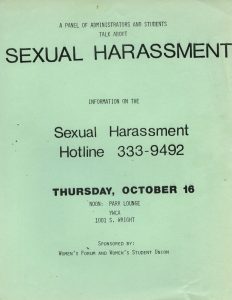This paper is part of the Student Researcher Series which showcases research students have conducted using resources in the Student Life and Culture Archives.
Cassidy Burke is a junior in the College of Liberal Arts & Sciences studying history and communication with a minor in Spanish and a Digitization Assistant at the University of Illinois Archives. She summarized her project by saying, “I chose to research the discussion of sexual assault at the University of Illinois Urbana-Champaign during the 1970s and 1980s. My research demonstrates that a handful of brave UIUC women during this time were at the forefront of bringing the discussion of rape and sexual assault into the public space. Dissonance & Disinterest shows the way women shaped rape prevention on campus, and how their efforts, while ignored at first, left a tremendous impact.” Cassidy presented her research at the Ethnography of the University Initiative Conference in December 2015.
Introduction

On July 2, 1974 the rape hotline at the University of Illinois at Urbana-Champaign received a call from a woman. The woman asked the hotline receptionist if she was being raped. The receptionist said, “No, are you?” The woman replied, “Yes-you should be. You don’t know what you’re missing.”[1] A day earlier, a woman called and asked if this was “the rape hotline where you call when you been raped or sexually assaulted, right?” The receptionist said yes, and the woman on the other end hung up. Three minutes later, the same number called back, but hung up immediately. Two minutes later, the same number called and instead a male voice said, “How big’s your pussy?”[2] A month earlier, a woman called the rape hotline after she experienced stomach pains following being raped. After the rape hotline tried multiple times to get back in touch with the woman, the woman revealed in a second phone conversation that five men gang raped her the night before; she was unsure whether or not to report the crime. She knew the man who forced her into this disturbing and unthinkable violence.[3] In the 1970s and 1980s, rape at the University of Illinois existed and created deafening silence surrounding sexual violence all over campus. Many woman and men who did call the rape hotline to report a rape often got cold feet and as demonstrated above, many students made a joke of the rape hotline, with crude or phony stories. Continue reading “Dissonance & Disinterest: Sexual Assault and the University of Illinois at Urbana-Champaign”